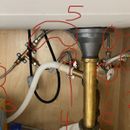Low pressure kitchen faucet
our kitchen faucet is still low pressure after the reno and I removed the restrictor at the spray too.
is the way he designed and did the installation with the pipping incorrect in anyway?
1) cold water supply to the faucet
2) cold water supply to the fridge (ice and water dispenser)
3) hot water supply to the faucet
4) hot water supply from the building
5) hot water supply to the dishwasher
6) cold water supply from the building
Any help would be appreciated! Just want stronger pressure in the kitchen faucet. And if this contraption the contractor did is wrong want to add to the punch list of items.
GBA Detail Library
A collection of one thousand construction details organized by climate and house part










Replies
Remove the aerator from the faucet and time how long it takes to fill a bucket, both hot and cold. You should be able to get at least two gallons per minute. If you don't, you can disconnect the hoses that connect the faucet to the supply lines and attach another hose and test there.
My suspicion is that the faucet is just working "as designed." My personal preference would be to have the kitchen sprayer be somewhere between a garden hose and a pressure washer, but faucet designers seem not to agree and they're usually pretty weak.
I also think it is likely your faucet is working as required by law that limits you to 2.2 GPM welcome to the green new world.
Walta
The flow restrictors in kitchen faucets are unfortunate, but as Walta mentioned, often required. The idea is low flow will "save water", which is true (to a point), with something like a bathroom sink primarily used for hand washing. In a kitchen though, you're often filling a pot, and a flow restrictor does nothing in that case except to make it take longer, wasting your time. This is an example of a well intentioned, but poorly executed, regulation, unfortunately.
See if there is a second flow restrictor in the system somewhere. Many kitchen faucets have one in the aerator, and another hidden in the supply line somewhere. Suspicious discs with small holes are likely offenders here.
Bill
Hi Bill,
I removed the flow restrictor in the spray already and it did help a little. So the supply line that connects to the wall that came with the faucet might be where the 2nd restrictor could be? So there would porbably be 2, 1 in hot and 1 in cold.
Thanks
I usually find a second restrictor in a coupler in one of the small attached lines. Not all faucets have a second restrictor, but it's common enough to check to be sure.
It's also true, as mentioned in post #5, that very small lines of any length restrict the flow too even without any intentional flow restrictors being added. The only thing you can do about this is to cut those lines back as much as possible prior to connecting them to the supply lines in the wall, which are usually 1/2", sometimes as small as 3/8", but never as small as the ~1/4" (ish) lines you often see as the supply pigtails on the faucet assemblies.
BTW, don't cut those lines back so much that you complicate your installation. A few inches won't make much difference in flow, so if you need 8" to make it easy, but 6" is the minimum you can work with, leave it at 8". What you don't want is 18" when you only need 8".
Bill
Is it just me, or do those supply lines (#1 & #3) that run to your faucet look thin/small? Also, that copper connection. that splits your hot water supply line might also be "reducing" the flow simply by its design. Different brands of Pex pipe have small ID's and for the same size pipe. Could this be causing your problem?
You need to do a test like DC suggests. Turn on your cold faucet and time how long it takes to get a gall0n. Do the same with your hot water.
Then turn off your water supply, disconnect the supply hoses that run to your faucet and do the same tests with those. Are the flow rates different?
You need to determine if it's coming from the wall, the supply hoses or your faucet. Then you can go from there.
BTW, #4 and #6 (building supply) look bigger than #1 and #3 (faucet supply).
The dishwasher and ice maker should have its own shutoff and supply teed off the copper line coming into the cabinet, not tapped off of the supplies to the faucet. Check the washers in the supply lines to see how small they are. If the water was turned off and all this work was done, it is possible that rust or debris loosened by the water being turned off and on may have accumulated in the lines. Best to disconnect the supply lines from the shutoff and flush it out there first....then pipe the appliances correctly.